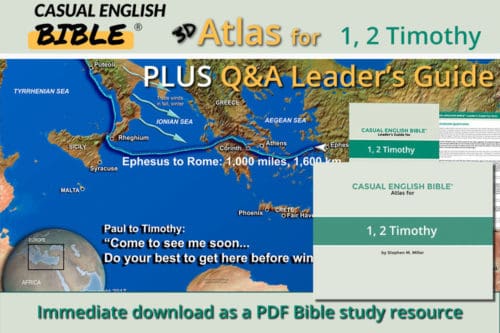
Not so in the town where he assigned his associate Timothy to stay: Ephesus. Paul lived there for three years, getting the church up and running. That was a huge investment of his time—twice as long as the year and a half that he spent in Corinth.
Fake religion greets Paul
Paul was not about to let fake Christians infiltrate and brainwash his congregation, which is what they were trying to do.
After Paul’s three-year stay in Ephesus, he and Timothy made a follow-up visit. They found a group of supposed Christian teachers spreading a warped brand of Christianity. Paul doesn’t say much about what the heretics taught. But it seems as though they tried to spread fake news that “the resurrection has already happened” (2 Timothy 2:18).
Paul couldn’t stay long enough to neutralize the theological poison, so he left Timothy there, perhaps as an apostle’s delegate. But for all practical purposes, Timothy may have served as the pastor or possibly as the bishop over several pastors in the region.
How to be a pastor
In the two letters Paul wrote to Timothy, he gave him advice about how to select pastors and how to be a good pastor. That’s why Bible experts call these letters, along with a similar letter Paul wrote to an associate named Titus, the Pastoral Epistles. Epistles is a two-dollar word for a one-nickel word: letter.
Two Timothy is a deeply personal letter. When Paul wrote that letter, he knew he was about to die. He asks Timothy to come to Rome as soon as possible because like most folks about to die, Paul wants the people he loves most to be with him when it happens.
The Bible never tells us if Timothy was able to make the 1,000-mile (1,000 km) trip in time.
Writer
“From: Paul, an apostle of Christ Jesus” (1 Timothy 1:1; 2 Timothy 1:1).
Timeline
One popular theory: Paul wrote 1 Timothy along with Titus sometime after his trial in Rome (about AD 62) and 2 Timothy about five years later. The book of Acts ends with Paul waiting for his trial in the emperor’s supreme court. As the theory goes, Paul was found not guilty and released. He hit the road again, possibly taking the story of Jesus to Spain, on the Roman Empire’s western frontier. The theory says he was arrested again after Emperor Nero blamed Christians for starting the fire that destroyed much of Rome in AD 66. Paul may have written 2 Timothy in about AD 67, while waiting for the Romans to execute him after a second trial.
 Paul’s location
Paul’s location
Paul doesn’t say where he was when he wrote 1 Timothy. Some scholars guess that he wrote it during his continuing mission trips that aren’t mentioned in the Bible—possibly on the trip he said he wanted to make to Spain (Romans 15:24). He wrote 2 Timothy from prison in Rome (2 Timothy 1:17).
Destination of letter
Paul wrote both letters to the man who was perhaps his best friend: Timothy, whom he called “my true son in spirit” (1 Timothy 1:2). Paul had assigned Timothy to stay in Ephesus, a bustling port city on what is now the west coast of Turkey. Timothy’s job: “Stay in Ephesus and keep telling those certain folks who are spreading warped teachings to stop it” (1 Timothy 1:3).





